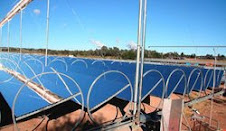In the field of photovoltaics, a photovoltaic module is a packaged interconnected assembly of photovoltaic cells, also known as solar cells. An installation of photovoltaic modules or panels is known as a photovoltaic array.
Photovoltaic cells typically require protection from the environment. For cost and practicality reasons a number of cells are connected electrically and packaged in a photovoltaic module, while a collection of these modules that are mechanically fastened together, wired, and designed to be a field-installable unit are known as a photovoltaic panel or simply solar panel.
A photovoltaic installation typically includes an array of photovoltaic modules or panels, an inverter, batteries (for off grid) and interconnected wiring.
Contents [hide]
1 Crystalline silicon modules
2 Rigid thin-film modules
3 Flexible thin-film modules
4 External Links
5 See also
[edit] Crystalline silicon modules
The most common design of modules contains 72 cells connected in three strings. The cells are connected using conductive ribbons into 'strings'. The strings are sandwiched between a solar glass frontside and a flexible durable polymer backsheet, using a polymeric encapsulant. The encapsulant is melted and crosslinked in a vacuum laminator. The strings are electrically terminated into a junction box usually glued to the back of the module. A frame made of aluminium profile is fitted around the edges.
1. Cells connected to make string
2. encapsulant film ready
3. ready for lamination. Note ribbons terminating 2 strings
4. after lamination
5. Aluminium profiles added to make the frame
[edit] Rigid thin-film modules
In rigid thin film modules, the cell is created directly on a glass substrate or superstrate, and the electrical connections are created in situ, so called "monolithic integration". The substrate or superstrate is laminated with an encapsulant to a front or back sheet.
The main cell technologies in this category are CdTe, amorphous silicon, micromorphous silicon (alone or tandem), or CIGS (or variant).
[edit] Flexible thin-film modules
Flexible thin film cells are created by depositing the photoactive layer and other necessary layers on a flexible substrate. If the substrate is an insulator (e.g. polyester or polyimide film) then monolithic integration can be used. If a conductor then monolithic integration cannot be used, and another technique for electrical connection used. The cells are converted to a module by lamination to a transparent colourless fluoropolymer on the front side (typically ETFE or FEP) and a polymer suitable for bonding to the final substrate on the other side. The only commercially available (in MW quantities) in a flexible module is amorphous silicon triple junction (from Unisolar)
[edit] External Links
Illustration of manufacturing process of crystalline silicon modules at DuPont website
Video of cSi module manufacture process at the Spire corp website
[edit] See also
Energy Portal
Photovoltaics
Photovoltaic array
Photovoltaic cells
Building-integrated photovoltaic
List of photovoltaics companies
Best Green Stocks Investing Blog
Subscribe to:
Post Comments (Atom)
Yuya Joe Blog
Lake Ontario Waterkeeper
The Daily Beast -Politics Blog
21stArch.com - 21st Century Architecture
Original Joe College Blog
WikiLeaks Foreign Policy Analysis
AGreenRealtor.com Real Estate Blog - Ecology Energy Efficiency
Best Green Stocks Investing Blog
PV Intell Photovoltaic Solar Stocks Investing
SEARCH Leading Alternative Energy and Ethical Investing websites

Custom Search
Daily Kos
Rare Earth Stocks Research
Patrick MacManus's Blog Peace and Collaborative Development
BeesTreesFrogsElephants.com - Nature and Ecology Blog
Research Green Energy stocks, Clean Energy investing information
Find wind power investing info online, clean energy mutual funds, geothermal stocks, solar energy investments.

Green Energy Investing Network:
Green Stocks Investing Clean Power Blog
SolarIntell.com Renewable Power Investing Website
Wind Intell.com Wind Energy Stocks Company Links
Geothermal Power Investing Public Companies
PV Intell.com Leading Photovoltaic Solar Energy Stocks

Custom Search
Green Energy Investing Network:
Green Stocks Investing Clean Power Blog
SolarIntell.com Renewable Power Investing Website
Wind Intell.com Wind Energy Stocks Company Links
Geothermal Power Investing Public Companies
PV Intell.com Leading Photovoltaic Solar Energy Stocks







No comments:
Post a Comment